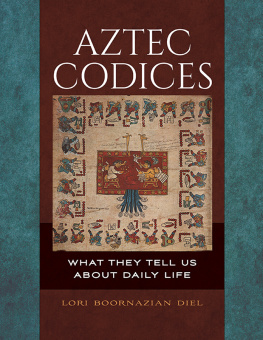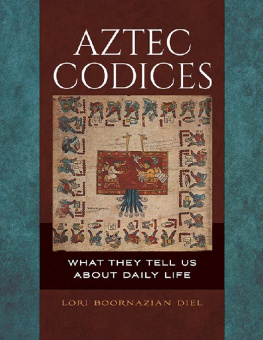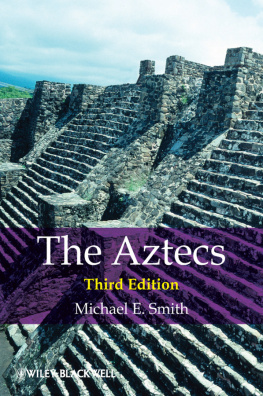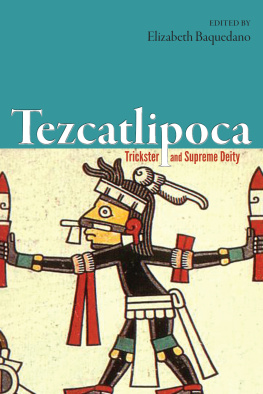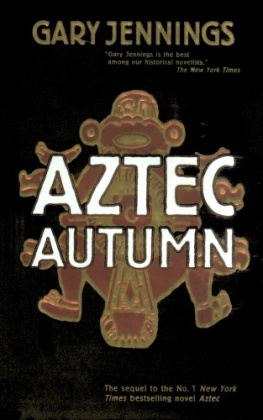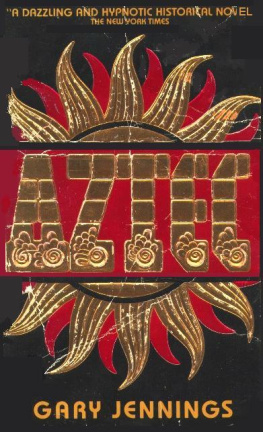Diel Lori Boornazian - Aztec Codices: What They Tell Us About Daily Life
Here you can read online Diel Lori Boornazian - Aztec Codices: What They Tell Us About Daily Life full text of the book (entire story) in english for free. Download pdf and epub, get meaning, cover and reviews about this ebook. year: 2020, publisher: ABC-CLIO, genre: Detective and thriller. Description of the work, (preface) as well as reviews are available. Best literature library LitArk.com created for fans of good reading and offers a wide selection of genres:
Romance novel
Science fiction
Adventure
Detective
Science
History
Home and family
Prose
Art
Politics
Computer
Non-fiction
Religion
Business
Children
Humor
Choose a favorite category and find really read worthwhile books. Enjoy immersion in the world of imagination, feel the emotions of the characters or learn something new for yourself, make an fascinating discovery.
- Book:Aztec Codices: What They Tell Us About Daily Life
- Author:
- Publisher:ABC-CLIO
- Genre:
- Year:2020
- Rating:4 / 5
- Favourites:Add to favourites
- Your mark:
- 80
- 1
- 2
- 3
- 4
- 5
Aztec Codices: What They Tell Us About Daily Life: summary, description and annotation
We offer to read an annotation, description, summary or preface (depends on what the author of the book "Aztec Codices: What They Tell Us About Daily Life" wrote himself). If you haven't found the necessary information about the book — write in the comments, we will try to find it.
Aztec Codices: What They Tell Us About Daily Life — read online for free the complete book (whole text) full work
Below is the text of the book, divided by pages. System saving the place of the last page read, allows you to conveniently read the book "Aztec Codices: What They Tell Us About Daily Life" online for free, without having to search again every time where you left off. Put a bookmark, and you can go to the page where you finished reading at any time.
Font size:
Interval:
Bookmark:
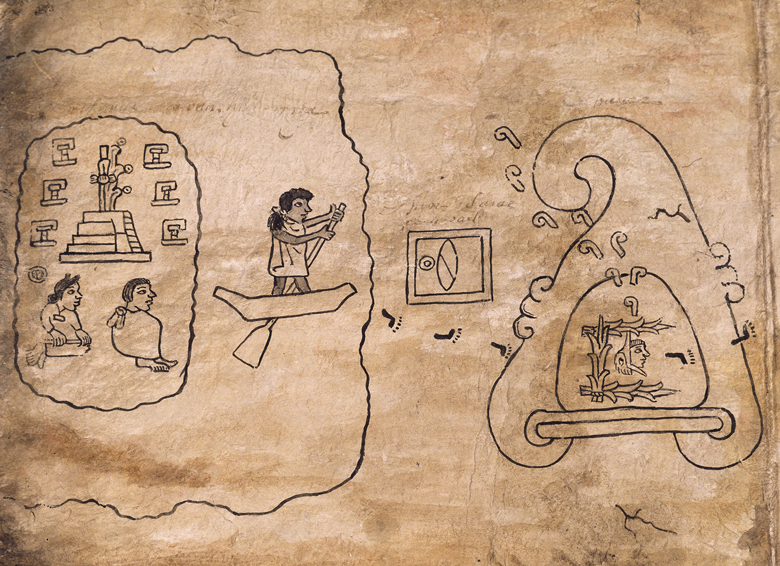
(Museo Nacional de Antropologa, Mexico City/DeAgostini/Getty Images)
The people who would eventually lead the Aztec empire were newcomers to central Mexico. They told a legendary tale of their migration from a place called Aztlan to their future capital at Tenochtitlan. Aztlan was described as a verdant island located somewhere in the north, while Tenochtitlananother islandwas described as a miserable swampy one in the center of a lake in the Valley of Mexico. Led by their patron god, Huitzilopochtli, the Mexica went through a number of trials and tribulations along their migratory journey, but from these challenges, they emerged as a strong group ready to grow into an imperial power. This migration story must have been an important component of Mexica history and identity as it is recorded in a fairly standardized manner in a number of Aztec codices. The story typically begins with their departure from Aztlan, a key historic event that carries symbolic implications that will resonate throughout Aztec history.
The first page of the Codex Boturini provides an iconic rendition of the start of the Mexica migration. At some point, a scribe added a few alphabetic notations in Nahuatl, the Aztec language, but these are difficult to read and were likely added after the imagery was painted. The colors used are black and white, with a bit of gray added to one figures skin tone. It is likely that the painter intended to finish the work with color but, for some reason, was unable to complete the task. The codex itself was left unfinished.
The main focus of the page is on the island of Aztlan, shown at the left. The Mexica settlement there is indicated with two figures seated in a wavy oval marking the island. The figure on the left is a woman. In Aztec pictorial writings, women are typically shown in a kneeling posture, and they wear a loose-fitting shirt, called a huipil, and a skirt. Married women also typically wear their hair in a braided and wrapped style with the ends of their braids placed at the tops of their heads, giving the appearance of horns. In this instance, the womans name is also provided. A small disk is linked to her head and depicts a shield (chimalli), which further identifies this woman as one named Chimalma, who is marked later in the manuscript as an important priestess who carries a bundle filled with sacred goods related to the Mexica patron god, Huitzilopochtli. The figure beside her does not carry a name tag, but he is marked as a man. In Aztec pictorials, men typically sit with their knees folded up in front, as seen here. In this case, the figures entire body, with the exception of his feet, is covered by a tilma, a white cotton cloak that is knotted at the shoulder and worn by Aztec men over a loincloth. He wears his hair in a simple, bowl-like style.
Above the couple is a temple shown in profile view, with tiers on the left and stairs on the right. At the top of the temple is a hieroglyphic compound of a reed stalk and water, which serves as a place sign for Aztlan, which translates as the Place of Reeds. This sign lets readers know that the island is indeed Aztlan, the ancestral homeland of the Mexica people. Flanking the temple are six iconic signs of houses. In Aztec pictorial writings, houses are shown in profile view in a schematized manner. The T shape suggests the post-and-lintel construction of the houses main door, with a platform below and an overhanging roof above. This same sign appears in the Aztec calendar for days and years associated with the House sign. The term calpulli, which translates as large house, was used by the Aztecs to reference linked groups of people, similar to kin groups or neighborhoods, and the six houses here may have been intended to suggest that there were six original calpulli at Aztlan.
The painter of the Codex Boturini indicates the departure from Aztlan with an image of a man rowing a canoe away from the island toward the mainland, which is indicated with another wavy line. The rowing migrants skin is painted an ashy gray. No other figure in this manuscript has this same skin coloring, so he is clearly distinguished from the other migrants. Most likely, his skin coloring marks him as a priestly leader, as Aztec priests customarily rubbed ash on their bodies as a religious action. The man also wears his hair in a longer, curly style that distinguishes him from other men in the manuscript and further marks him as a priest, who typically did not cut their hair. His mantle, or tilma, is shown with a slight fold and some lines indicating drapery, which points to this manuscript having been created after the conquest. Aztec artists who worked before the conquest were uninterested in conveying the illusion of volume or the fall of cloth, instead marking clothing with a flat wash of color.
The migrants arrival on the mainland is indicated by footprints, which record travel in Aztec pictorials. The footprints lead under a square frame that encloses a single disk and a simplified icon of a flint knife. This acts as a hieroglyphic construction recording the Aztec year 1 Flint, which tells the audience the year in which this seminal event took place. Unfortunately, the Codex Boturini is incomplete, making it difficult to correlate this year with our own calendar, though some sources place the start of the migration in the late twelfth century.
Continuing to read to the right, the Codex Boturini records the first stop for the Mexica migrants. In the Aztec pictorial writing system, iconic signs are used to indicate places, with the most typical being a stylized hill, which is shown with curls at the sides and an opening at the bottom. The painter of the codex includes one of these hill signs here, but he gives it a distinctive curl at its top in order to mark it specifically as a place called Teoculhuacan, which translates as the Sacred Place of the Curved Hill. It also translates as the Sacred Place of the Ancestors, as the Nahuatl word culli is a homophone, meaning both curved and ancestor. The migrants footprints lead directly into this hill sign, recording his arrival there, presumably with the rest of the Mexica migrants following him.
Inside the Teoculhuacan hill sign is a niche in which the migrants have set up a temporary altar to their patron god, Huitzilopochtli. The altar is simply constructed of branches from a tree, and the god is shown as a human face that emerges from the head of a hummingbird, which is a sign for Huitzilopochtli, whose name translates as Hummingbird of the South. A number of scrolls come from the godhead and mark speech. The implication is that the god is compelling his people to move forward once again, as suggested by footprints that lead from the gods altar toward the right, extending out of the niche and forward into time and new places on the following pages.
The Codex Boturinis record of the start of the Mexica migration is told with an economy of information. The image was meant to elicit an oral reading that would have provided more details on Aztlan and what compelled the Mexicas patron god to order his people to leave the island. Chronicles written after the conquest fill in some of this information for us. For example, according to Diego Durn, a Spanish friar who lived among the Aztec people during the sixteenth century and wrote their history, Aztlan was a paradise, a place where people lived in leisure, never grew old or weary, and never lacked anything. However, something adverse must have happened as Durn says that Huitzilopochtli was persecuted there and urged his people to leave Aztlan in search of a new homeland, which was their true destiny.
Font size:
Interval:
Bookmark:
Similar books «Aztec Codices: What They Tell Us About Daily Life»
Look at similar books to Aztec Codices: What They Tell Us About Daily Life. We have selected literature similar in name and meaning in the hope of providing readers with more options to find new, interesting, not yet read works.
Discussion, reviews of the book Aztec Codices: What They Tell Us About Daily Life and just readers' own opinions. Leave your comments, write what you think about the work, its meaning or the main characters. Specify what exactly you liked and what you didn't like, and why you think so.

